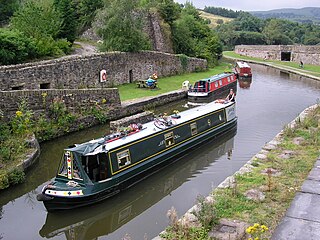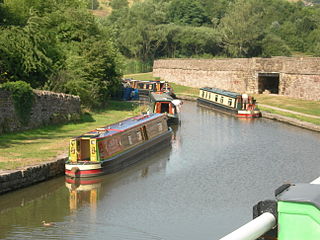
British Waterways, often shortened to BW, was a statutory corporation wholly owned by the government of the United Kingdom. It served as the navigation authority for the majority of canals and a number of rivers and docks in England, Scotland and Wales.

A narrowboat is a boat of a particular design, made to fit the narrow canal locks of the United Kingdom. The UK's canal system provided a nationwide transportation network during the Industrial Revolution, but with the advent of the railways commercial canal traffic gradually diminished and the last regular long-distance traffic disappeared in 1970. However, some commercial traffic continued into the 1980s and beyond.

The Oxford Canal is a 78-mile (126 km) narrow canal in central England linking Oxford with Bedworth via Banbury and Rugby. Completed in 1790, it connects to the River Thames at Oxford and is integrated with the Grand Union Canal—combined for 5 miles (8 km) close to the villages of Braunston and Napton-on-the-Hill, a canal which soon after construction superseded much of its traffic.

The British canal system of water transport played a vital role in the United Kingdom's Industrial Revolution at a time when roads were only just emerging from the medieval mud and long trains of packhorses were the only means of "mass" transit by road of raw materials and finished products. The UK was the first country to develop a nationwide canal network.

The Llangollen Canal is a navigable canal crossing the border between England and Wales. The waterway links Llangollen in Denbighshire, north Wales, with Hurleston in south Cheshire, via the town of Ellesmere, Shropshire. The name, which was coined in the 1980s, is a modern designation for parts of the historic Ellesmere Canal and the Llangollen navigable feeder, both of which became part of the Shropshire Union Canals in 1846.
The British Transport Commission (BTC) was created by Clement Attlee's post-war Labour government as a part of its nationalisation programme, to oversee railways, canals and road freight transport in Great Britain. Its general duty under the Transport Act 1947 was to provide an efficient, adequate, economical and properly integrated system of public inland transport and port facilities within Great Britain for passengers and goods, excluding transport by air.
Lionel Thomas Caswall Rolt was a prolific English writer and the biographer of major civil engineering figures including Isambard Kingdom Brunel and Thomas Telford. He is also regarded as one of the pioneers of the leisure cruising industry on Britain's inland waterways, and as an enthusiast for both vintage cars and heritage railways.

The canals of the United Kingdom are a major part of the network of inland waterways in the United Kingdom. They have a colourful history, from use for irrigation and transport, through becoming the focus of the Industrial Revolution, to today's role of recreational boating. Despite a period of abandonment, today the canal system in the United Kingdom is again in increasing use, with abandoned and derelict canals being reopened, and the construction of some new routes. Most canals in England and Wales are maintained by the Canal & River Trust, previously British Waterways, but a minority of canals are privately owned.

The Droitwich Canal is a synthesis of two canals in Worcestershire, England; the Droitwich Barge Canal and the Droitwich Junction Canal. The Barge Canal is a broad canal which opened in 1771 linking Droitwich Spa to the River Severn at Hawford Mill, Claines. The Droitwich Junction Canal is a narrow canal, opened in 1854, which linked Droitwich to the Worcester and Birmingham Canal. Both were built to carry salt, and were abandoned in 1939. They have been the subject of a restoration plan since 1973, and the Barge Canal was officially reopened in 2010, while the Junction Canal reopened in July 2011. Following the opening of the canal, ownership transferred to the newly created Canal and River Trust

The Standedge Tunnels are four parallel tunnels through the Pennine hills at the Standedge crossing between Marsden in West Yorkshire and Diggle in Greater Manchester in northern England. Before boundary changes in 1974, both ends of the tunnel were in the West Riding of Yorkshire. Three are railway tunnels and the other is a canal tunnel.
The IWA National Festival & Boat Show run by the Inland Waterways Association is one of the key annual events on the United Kingdom's inland waterways. Generally referred to as the "National" it serves several functions:

The Inland Waterways Association (IWA) is a registered charity in the United Kingdom and was formed in 1946 to campaign for the conservation, use, maintenance, restoration and sensitive development of British Canals and river navigations.

The Bugsworth Basin Heritage Trust (BBHT), formerly known as the Inland Waterways Protection Society (IWPS), is a British organisation founded in 1958 to work for the restoration of the canal system. Its members carried out surveys of canals and produced reports in support of their retention when much of the canal network was under threat. Following official support for use of the canals for leisure activities in 1967, the Society have concentrated their efforts on the restoration and operation of Bugsworth Basin, located at the southern end of the Peak Forest Canal, which was one of the first canals that they surveyed in 1958.
Coalisland Canal is a canal in County Tyrone in Ulster and is about 7.2 kilometres (4.5 mi) long. Construction of the canal began in 1733, but progress was slow and it was not officially opened until 1787. The canal was built to reduce the cost of transporting coal from the Tyrone coalfields to Dublin. An extension known as "Dukart's Canal" was built to link the coalfields of Drumglass with the head of navigation at Coalisland. It opened in 1777, but was an engineering failure, and closed when the main canal opened. After some difficulties with the infrastructure, traffic slowly increased, and did not reach its peak until 1931. Traffic then declined rapidly, and the canal was abandoned in 1954.
The flyboat was a European light vessel displacing between 70 and 200 tons, used in the late 16th and early 17th centuries; the name was subsequently applied to a number of disparate vessels which achieved high speeds or endurance.

Legging is a method of moving a boat through a canal tunnel or adit containing water. This method of navigating through canal tunnels and adits was commonly used in canal tunnels during the 18th and early 19th centuries.
Olga Kevelos was an English Motorcycle trials and enduro rider who was the only woman to win two gold medals at the International Six-Day Trial.

Narrow Boat is a book about life on the English canals written by L. T. C. Rolt. Originally published in 1944, it has continuously been in print since.

Sonia Rolt OBE FRS was a campaigner for the Inland Waterways Association (IWA) of Great Britain and was made an Officer of the Order of the British Empire in 2010 for her services to industrial archaeology and heritage.

Green and Silver is the account by Tom Rolt of a voyage through the inland waterways of Ireland just after the Second World War. It is notable because it was one of the last trips by any boat around the triangular loop of the River Shannon, Grand Canal and Royal Canal before the last named was closed to navigation. It was reopened in 2010.















